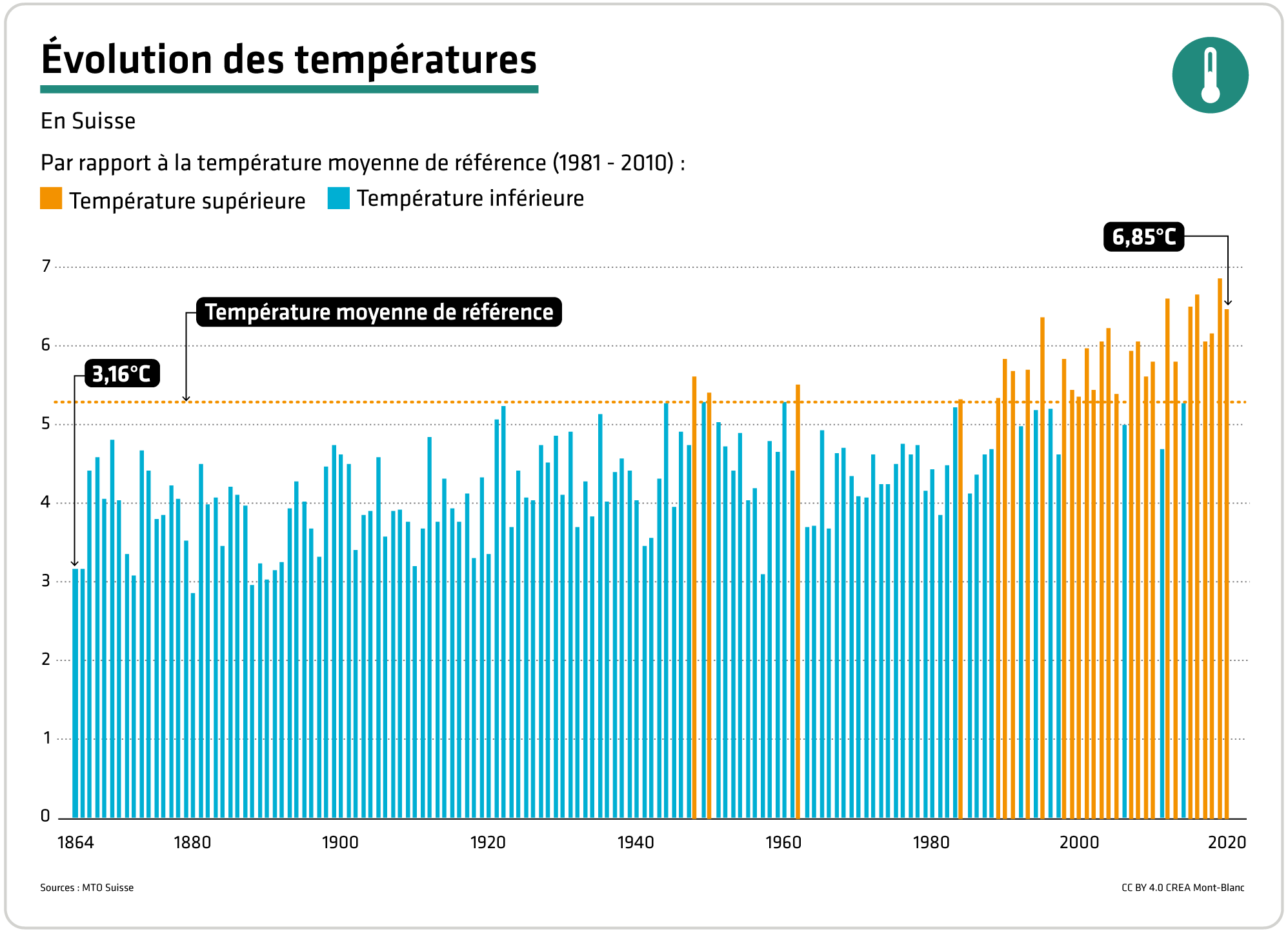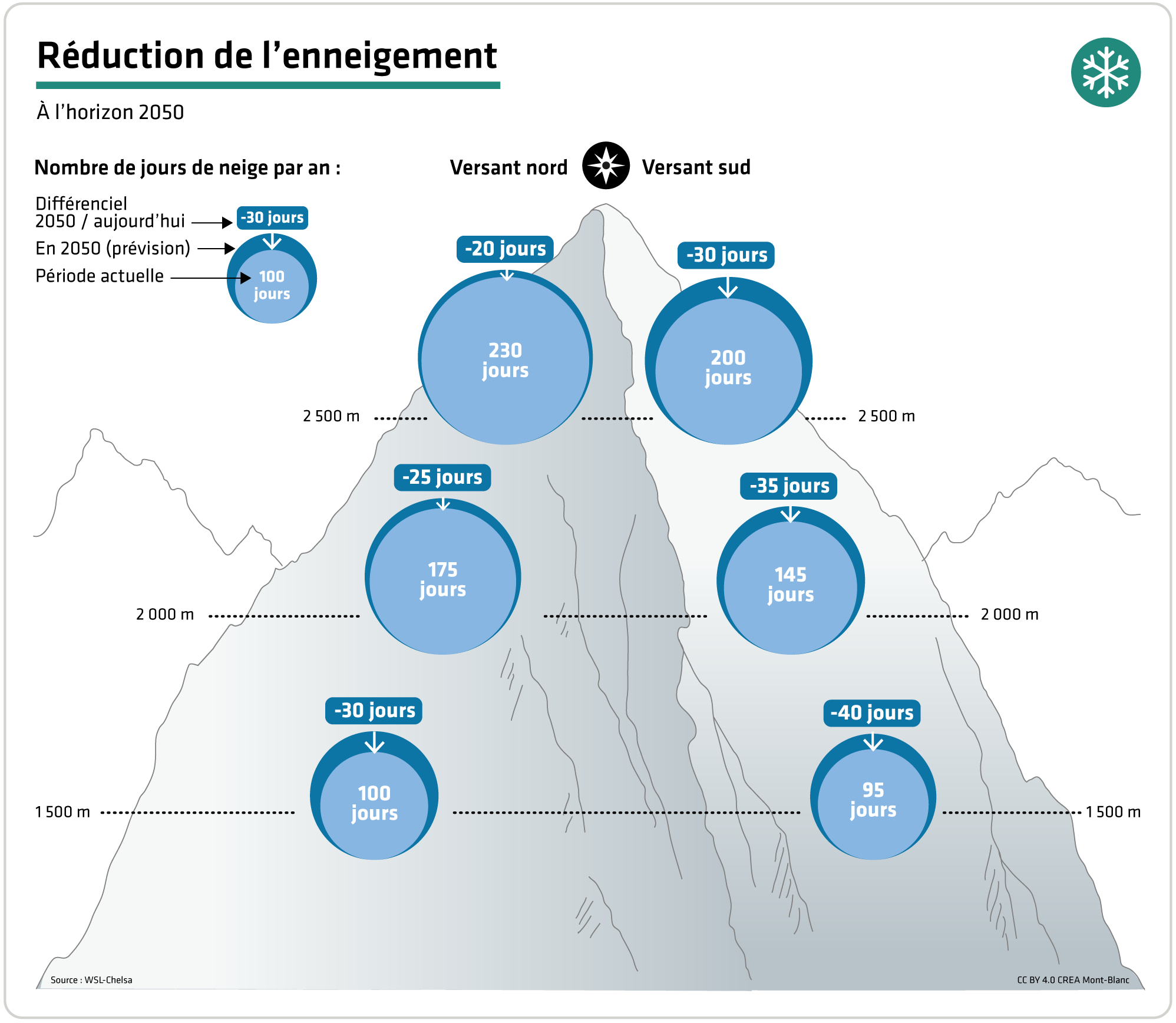Points to remember
- Climate change is affecting large mountains ranges two to three times faster than the rest of the planet.
- THe impact is now visible in the Mont-Blanc massif : glacial retreat, rockfalls, reduced snow cover.
- The upheavals for flora and fauna are less visible but just as profound.
- The emblematic landscapes of the Mont-Blanc massif have now changed.
Mountain : a natural environment firmly connected to the climate
In the mountain environment, climatic conditions vary with altitude. Air temperature drops by an average of 0.6°C for every 100-metre elevation, due to the atmosphere’s reduced absorption of solar rays. Remarkable changes in temperature occur not only from day to night but also between the seasons. Precipitations, including snowfall, are equally more significant at altitude.

Altitude is not the only factor to influence climatic conditions. The structure of the terrain, the topography, also plays a significant role. Sun exposure is responsible for varying conditions, generating semi-tropical conditions at ground-level facing south and semi-arctic conditions on the north side. This variability, dependent on the slopes, is mirrored on a micro-scale: on either side of a bump or rock, or between a valley that remains snow-covered and a windward ridge that is permanently cleared of snow. The result is a mosaic of climatic conditions and therefore species, sometimes juxtaposed within a few square metres.
The change in temperature from high to low altitude limits the presence of a species. For example, the forest tree line, with placement most visible to the naked eye, shows the temperature at which conifers no longer receive enough heat to ensure growth
To survive such conditions, biodiversity has adapted and specialised. There is a small number of species with very distinct characteristics that are only found in the mountain environment. These species thrive due to their ability for rapid development but with limited productivity, their conservation of energy, or their resistance in conditions of frost and drought.

See more : The Mont-Blanc, a unique massif ➞
Climate : changing faster than on the plains
In the Mont Blanc massif, as in the rest of the Alps, average annual temperature has risen by around 2°C since 1864. This is more than twice as much as the warming measured on a global scale (+0.9°C) and higher than that in France (+1.4°C). Since the 1980s, temperatures in the Alps have been rising between 0.2°C and 0.5°C per decade.

The measure of albedo - the fraction of the sun’s rays reflected or dispersed by a surface – provides something of an explanation for greater warming in the mountains. Rising temperatures result in reduced areas covered in ice or snow. These formerly white areas that reflected the sun’s rays are rendered darker, rockier areas which collect heat.
Find out more: Monitoring temperatures ➞This accelerated rise in temperatures has a major impact on snow cover. In the Northern Alps, the duration of annual snow cover between 1100 and 2500 metres has decreased by five weeks since the 1970s. By 2050, snow cover between valleys and south-facing 2000 metres risks reduction of 4 to 5 weeks compared to current levels, with a decrease of 4 weeks predicted at 2500 metres. Above 3000 metres, snow cover is not expected to change.
Find out more: Snow cover declines ➞


Climate change affects each season differently. In the Mont-Blanc massif, the greatest temperature rise occurs during the summer, with longer-lasting droughts and heatwaves occurring more regularly and expected to become even more frequent by 2050. However, the season that is most affected is spring, where rising temperatures have a direct impact on the melting rate of the snowpack. Spring is a crucial season for flora and fauna, as renewed access to resources previously covered by snow allows animals to resume their activity, whilst vegetation begins to grow again.
Find out more: temperatures in the massif ➞Not all species react in the same way, not responding to climate change to the same extent or at the same rate. Moreover, it is sometimes observed that the different parameters of climate change (reduced snow cover, heat waves, drought, etc.) produce contradictory reactions from the same species.
Seasons : modified cycles for the fauna and flora
The most notable response to climate change is a significant shift in the timings of seasonal events. Insects, butterflies, and reptiles - animals which do not regulate their body temperature and are therefore highly dependent on the outside temperature – advance their seasonal cycle by an average of six days every ten years.
Birds and mammals are the least responsive, with their cycles advancing by an average of one day per decade. This milder response could be attributed to their mobility, allowing them to relocate to their optimal conditions relatively easily, or by a lesser adaptive capacity, as their seasonal cycle is more influenced by the photoperiod (daylight duration) than by temperature.
Plants also alter their cycle, bringing it forward by an average of 2 to 3 days per decade. This shift is most noticeable amongst trees and shrubs. Birch and ash trees, for instance, have responded significantly to the rise in spring temperatures, advancing their cycles by 4 to 6 days in the past decade.
Find out more: Phenoclim: keeping pace with the trees ➞The extended duration of the favourable season as a result of the rise in temperature could therefore prove advantageous for all species, across all environments. However, climate change also presents minor and sometimes contradictory effects. An example of this can be seen in larch trees, where elevated spring temperatures encourage buds to open early at high altitudes. Contrarily, the winter cold, an essential precursor to blooming, is no longer intense enough at lower altitude, which may counteract some of the benefits of an early spring and explain why larch trees in the valleys are blossoming later than those at higher altitudes.
The same is true for common frogs during periods of summer drought. These frogs benefit from early snow clearance, granting them earlier access to breeding pools, thereby extending the growth season for the tadpoles. However, at times, summer droughts lead to the pools drying up prematurely, preventing the tadpoles from completing their development.
Find out more : Red frogs: a double-edged sword of warming ➞
Species distribution : ascending migration to escape the heat
In conjunction with the altered seasonal cycles, another response to climate change is the general tendency of living organisms to migrate to higher elevations in search of optimal living conditions.

The most significant migrations observed thus far involve an ascent of 45 metres per decade by insects and 17 metres by snails. Here again, the response remains more pronounced amongst species that do not regulate their own temperature and are directly dependent on external conditions.
Among plants, it is the trees and shrubs which ‘climb’ the quickest in altitude. Ascension of the forest tree line is the most visible aspect of altitudinal migration. In the Mont Blanc massif, the average altitude of the forest rose by 60 metres between 1952 and 2006 and could reach 100 metres by 2050 according to the layout of the environment. However, this ascent is not solely attributable to climate change; it is also influenced by agricultural and pastoral activity abandonment. We can therefore envisage a net augmentation of surface area occupied by forest, projected to expand from 90km2 in the 1950s to 230km2 in 2050.
Birds and mammals strive to adapt to the evolution of their habitats. The sharp decline in alpine meadows and the growth of forest and moorland, comprising less favourable vegetation such as rhododendrons and junipers, have led to a reorganisation of herbivore communities (including red deer, chamois, roe deer, and ibex) that is still poorly understood.
Find out more : Monitoring wild herbivores ➞At the current pace of temperature increase, species would need to ascend 100 metres each decade to maintain the same temperature. It is probable that certain species will struggle to keep up with such rapid change. What’s more, given the “knife-edge” structure of mountain terrain, the available surface area lessens the higher you go, indicating that in the future, there won’t be room for all species in the same abundance.
Ecosystems : the interplay between species and disrupted landscapes
Not all species move in time or space at the same rate, yet each species interacts with others to form an ecosystem. While certain species will thrive, others will be significantly set back by the impacts of global warming. These distinct adaptations and responses to climate disruption result in heightened competition, the loss of synchronisation between species or their surroundings, and ultimately to significant changes to the landscape.
For instance, an escalation of competition with species of the plains is evident. The mountain hare finds itself in increased competition with the brown hare of the plains, whose migration in elevated altitude means feeding on the mountain hare’s lower territories. Similarly, at the summits, the current rise in species diversity is accompanied by the potential ousting of alpine plants by more competitive species from lower altitudes over time.
Instances of desynchronisation are becoming apparent between the species well-adapted to an environment and that same environment which is rapidly transforming. This is the case for the mountain hare, ptarmigan and stoat which change to white fur in winter, to better blend into the landscape and evade predators. The timing of their moulting remains relatively constant as it depends more on the daylight duration than the temperature. However, with the snowpack melting earlier each year and the animals retaining their white coats in a landscape that is no longer white, this means exposure to predators.
Another instance involves the ibex, where the timing of birthing depends on the date of mating which takes place in autumn. In years with a warm winter and/or spring, an imbalance occurs between the peak vegetation growth, which happens sooner, and the ibexes’ grass consumption requirements. This has led to the observation of an increased mortality rate of young ibex in the Gran Paradiso National Park in Italy during the years following early springs.
At the landscape level, this is a real transformation stemming from the evolution of species and their interactions. The forest is ascending and undergoing changes, meaning it will no longer be composed of the same species. There will be an increased prevalence of deciduous trees and fewer conifers. At higher altitudes, we are witnessing a transformation of the massif, with a belt of vegetation encroaching upon the traditionally snow-covered zones. The Alps are getting greener. Satellite imagery shows that it is the high mountain terrain (around glaciers, firns, and mountain faces) where the greening is most pronounced.
Outlook : great potential for change - dependent on our action or inaction"!
The abilities of living organisms to adapt, despite their advanced evolution in the mountains, is being put to the test. The marked acceleration of climate change in the Alps leaves little time, whereas the usual evolutionary mechanisms typically require multiple generations to find solutions to new environmental conditions.

Furthermore, the mix of climate change with other pressures on natural environments, such as soil artificialisation, degradation of natural habitats, and mass tourism, prevents species from moving in pursuit of new territories in line with their climatic needs.
Mountain terrain does however hold distinct advantages, such as the diversity of natural environments on a small scale. Whilst a species on the plains might need to traverse hundreds of kilometres to find suitable conditions, in the mountains, a mere few metres may be all that’s required to find the optimal temperature. Moreover, there are many areas in the Mont Blanc massif that have experienced minimal or no human intervention, far more than those found on the plains. As glaciers recede and snow cover diminishes, new territories will become accessible to plants and animals. These areas could serve as refuges for biodiversity, provided they remain undisturbed by human activity.
By granting species the time and space to adapt – a feat which they achieved throughout history – we uphold evolutionary potential by safeguarding strong biological diversity. Our human activities and practices can either help or hinder these adaptations. Nevertheless, in all cases, we too will need to adapt to these changes. Whether it entails the forest’s ascension in altitude, the dwindling prevalence of certain common species, or the recurrent droughts endured by alpine environments, the repercussions will significantly impact our activities and our perception of the mountain landscape.
Continue exporing ➞
References

The booklet Nature loosing its bearings published by CREA Mont-Blanc presents the main principles of alpine ecology that you will find in this you will find in this Atlas of Mont Blanc, as well as the responses of animal and plant species to climate change in the mountains. It is available for free in PDF format.
Read or download the PDF online ➞
- Asse D., Chuine I., Vitasse Y., Yoccoz N.G., Delpierre N., Badeau V., Delestrade A., Randin C.F. (2018). Warmer winters reduce the advance of tree spring phenology induced by warmer springs in the Alps, AGRICULTURAL AND FOREST METEOROLOGY 252: 220-230.
- Beniston, M., Farinotti, D., Stoffel, M., Andreassen, L. M., Coppola, E., Eckert, N., Fantini, A., Giacona, F., Hauck, C., Huss, M., Huwald, H., Lehning, M., López-Moreno, J.-I., Magnusson, J., Marty, C., Morán-Tejéda, E., Morin, S., Naaim, M., Provenzale, A., Rabatel, A., Six, D., Stötter, J., Strasser, U., Terzago, S., and Vincent, C. (2018). The European mountain cryosphere: a review of its current state, trends, and future challenges. THE CRYOSPHERE 12: 759–794.
- Bison M., Yoccoz N., Carlson B.Z., Delestrade A. (2018). Comparison of budburst phenology trends and precision among participants in a citizen science program INTERNATIONAL JOURNAL OF BIOMETEOROLOGY 63 : 61-72.
- Cremonese E., Carlson B., Filippa G., Pogliotti P., Alvarez I., Fosson JP., Ravanel L. & Delestrade A. AdaPT Mont-Blanc : Rapport Climat: Changements climatiques dans le massif du Mont-Blanc et impacts sur les activités humaines. Rédigé dans le cadre du projet AdaPT Mont-Blanc financé par le programme européen de coopération territoriale Alcotra Italie-France 2014-2020. Novembre, 2019, 101 p
- Filippa, G., Cremonese, E., Galvagno, M., Isabellon, M., Bayle, A., Choler, P., Carlson, B.Z., Gabellani, S., Morra di Cella, U & Migliavacca, M. (2019). Climatic Drivers of Greening Trends in the Alps. REMOTE SENSING, 11(21), 2527.
- NCCS (éd.) 2018 : CH2018 - Scénarios climatiques pour la Suisse. NATIONAL CENTRE FOR CLIMATE SERVICES, Zurich. 24 pages. Numéro ISBN 978-3-9525031-1-9
- Pettorelli N., Pelletier F., Von Hardenberg A.,Festa-Bianchet M., Côté S.D. (2007). Early onset of vegetation growth vs. rapid green-up: impacts on juvenile mountain ungulates. ECOLOGY 88(2): 381-90.
- Vitasse Y., Ursenbacher S. Klein G, Bohnenstengel T, Chittaro Y, Delestrade A., Monnerat C., Rebetez M., Rixen C., Strebel N., Schmidt B. R., Wipf S., Wohlgemuth T., Yoccoz N.G., Lenoir J. (submitted 2020). Phenological and elevational shifts of plants, animals and fungi under climate change in the European Alps. BIOLOGICAL REVIEW.
- Yoccoz N.G., Delestrade A. & Loison A. (2010). Impact des changements climatiques sur les écosystèmes alpins : comment les mettre en évidence et les prévoir ? REVUE DE GÉOGRAPHIE ALPINE 98-4.











